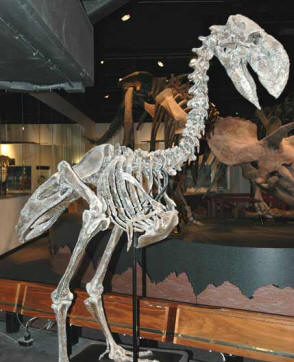 |
 |
 |
 |
 |
Produced
by the Population Genetics and Evolution class, Furman University |
||||
 |
 |
 |
 |
 |
Produced
by the Population Genetics and Evolution class, Furman University |
||||
 |
The
Paleogene: Diatryma |
 |
||
| The genus
Diatryma contains four extinct species of relatively large flightless
birds. They stood well over two meters tall and could weigh up to 100
kilograms. They possessed a disproportionally massive head that could
be fifty centimeters long, including a beak over twenty centimeters long
(Hooper Museum 2010).Diatryma also possessed thick legs with
clawed feet and tiny wings. During its era of existence, it has been considered
by many to have been the top predator in modern Western Europe and North
America (Enchanted Learning 2010). Interestingly enough, the debate as
to whether Diatryma was carnivorous or herbivorous still continues.
Some claim that its large and powerful beak was used to crack apart nuts
like parrots. Others who analyzed the biomechanics of its jaw claimed
that the flightless bird was carnivorous (Hooper Museum 2010). However,
all modern day large flightless birds, such as ostriches, are all herbivorous
(Arizona Museum of Natural History 2010). An interesting theory as to
why Diatryma went extinct stated that small and agile carnivorous
mammals such as Cladosictis devoured many of its eggs and young
offspring, leading to massive drops in population levels (Enchanted Learning
2010). Page by Iggy Gaska |
 |
| Skeletal Deinonychus leaping towards its prey. From: American Museum of Natural History.2010. | |
|
Arizona Museum of Natural History. 2010. Diatryma. Dinosaur Hall. Accessed April 11, 2010. Enchanted Learning. 2010. Diatryma. Accessed April 12, 2010. Hooper Museum. 2010. Diatryma. Accessed April 12, 2010. |